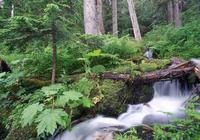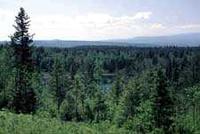Forests
FORESTS in BC grow in a great range of types and habitats, and the temperate RAIN FORESTS along the coast are among the most biologically rich and diverse forests in N America. Much of BC is covered with a series of MOUNTAIN ranges running north and south, which become progressively higher moving eastward from the Pacific. This terrain shapes the 2 major climatic influences—warm, moist air sweeping east from the ocean and dropping precipitation as it rises over the mountain ranges, and cold Arctic air flowing southward down the valleys between the mountain ranges—creating a wide variety of regional conditions. BC forests have evolved in the 10,000 years since the last GLACIERS began their retreat. As the ice melted, flora and fauna repopulated the scoured land from unglaciated refugium to the south, on the QUEEN CHARLOTTE ISLANDS, and the BROOKS PENINSULA on the northwest coast of VANCOUVER ISLAND. Today about 450,000 sq km, almost one-half of the province's land area, is forested. More than two-thirds of Canada's bird and land mammal species are found here (see BIODIVERSITY). For many species, such as the grizzly BEAR, BC forests have become the last refuge in N America. The forests also maintain a large network of WETLANDS, LAKES, RIVERS and streams that contain large populations of fish. Prior to the development of HYDROELECTRIC dams on some rivers and excessive exploitation in other areas, all the major river systems west of the ROCKY MTS flowing into the Pacific supported huge populations of SALMON.
For the sake of simplicity, scientists have identified 12 forest types in BC (see BIOGEOCLIMATIC ZONES). The major division is between Coastal and Interior forest zones. Coastal forests contain several tree species that grow to an enormous size (see TREES, GIANT). On the South Coast surrounding GEORGIA STRAIT is the coastal DOUGLAS FIR zone, where trees of that species have been known to grow to a height of 120 m and to an age of more than 1,000 years. Other species in this zone include western HEMLOCK, western red CEDAR, yellow cedar, Sitka SPRUCE, red ALDER, bigleaf MAPLE, Garry OAK and Pacific DOGWOOD. At higher elevations in the south and along the remainder of the coast is the coastal western hemlock zone, the most productive forest zone in BC. Cooler and wetter than the fir zone, it also contains Douglas fir in drier sites, amabilis FIR, western red and yellow cedar. At higher elevations along the entire coast lies the mountain hemlock zone, also containing significant amounts of amabilis fir and yellow cedar. The hot, dry South-Central Interior has a ponderosa PINE zone at low elevations, consisting of a relatively open forest interspersed with areas of bunchgrass and scrub sage. The mid-elevation slopes of this area and other areas to the north, as well as valley bottoms in the E and Central KOOTENAY, make up an Interior Douglas fir zone. It also contains lodgepole and ponderosa pine, aspen, BIRCH, western red cedar, Engelmann and white spruce, western LARCH and grand fir. Low and middle elevation slopes in southeastern BC, and a smaller area in the valleys of the SKEENA and NASS rivers in the northwest, host the Interior cedar–hemlock zone. This is the second most productive forest zone in the province. Because it is the wettest Interior zone, western red cedar and hemlock dominate, with several species of spruce, western larch, grand and Douglas fir, aspen, birch and black cottonwood also present. Central BC, in a large area surrounding PRINCE GEORGE, is dominated by the sub-boreal spruce zone. It is populated mostly by Engelmann and white spruce and subalpine fir; lodgepole pine, Douglas fir and black cottonwood are also present. The far northern and northeastern portions of the province are part of the boreal forest that stretches from Alaska to Newfoundland in North America. This is known as the boreal white and black spruce zone, and its major species also include lodgepole pine and aspen. The mid-elevation slopes of northwestern and north-central BC are in the spruce–willow–birch zone, a mostly scrub forest that contains scattered stands of white spruce, subalpine fir and lodgepole pine. Most of the higher elevations in the Interior occupy the Engelmann spruce–subalpine fir zone, where these species grow in scattered stands interspersed with alpine tundra and alpine meadows. Where this zone overlaps in mid-elevation slopes with the Interior Douglas fir zone, there exists a small montane spruce zone dominated by lodgepole pine and containing a mixture of species from the other 2 zones. High mountain slopes throughout the province have an alpine tundra zone consisting of a sparse growth of stunted subalpine fir, Engelmann spruce, mountain hemlock and whitebark pine.
In the past 140 years about 95,000 sq km of BC's forests have been logged, and about the same amount have been burned by fire. See also ENDANGERED SPECIES; FOREST FIRES; FOREST POLICY; FOREST PRODUCTS; LOGGING.
by Ken Drushka
Reading: Cameron Young, The Forests of British Columbia, 1985.


